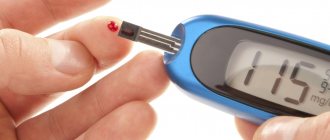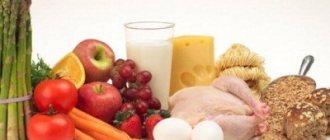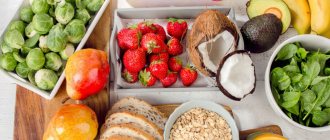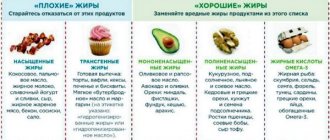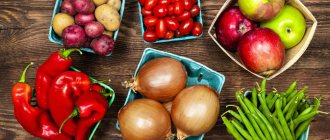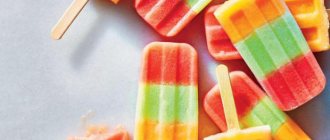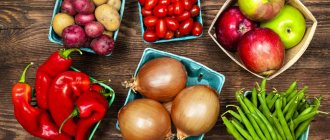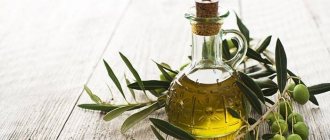General principles of diet
The cholesterol diet is not classified as strict, because the list of what you can eat is extensive. The peculiarity of nutrition is that you can only eat products of natural origin. The human body cannot function normally without the intake of fats. At the same time, cholesterol also increases due to excessive amounts of fat. Therefore, to avoid deficiency and excess, it is necessary to consume fats of vegetable origin.
General nutritional recommendations are the following:
- eat small meals 5-6 times a day;
- When purchasing, check the freshness of the goods so as not to eat expired or spoiled products;
- drink plenty of fluids, especially clean water and green tea;
- limit your salt intake, the permissible daily salt intake is 5g;
- reduce the amount of fat;
- Eat as many fresh vegetables and fruits as possible every day;
- eat foods containing fiber.
In order for the diet to bring maximum benefit, it is necessary to strengthen the body with physical activity and walks in the fresh air. In other words, a healthy lifestyle, including diet, is necessary for high cholesterol. With its help you can do it even without the use of medications.
What is cholesterol and its role in the body
In addition to fats (lipids), the body also contains fat-like substances (lipoids).
Lipoids include phospholipids, glycolipids and steroids, which are essential components of all biological membranes of the body (cell membranes). The membranes are 60% proteins and 40% lipids. Cholesterol (or cholesterol) also belongs to the steroid structure lipoids. Thus, without cholesterol it is impossible for cells to exist as independent entities.
Cholesterol is a precursor to:
- bile acids (necessary for the emulsification of dietary fats and normal digestion);
- steroid hormones (adrenal cortex, male and female sex hormones);
- vitamin D (formed from cholesterol only under the influence of sunlight; without this vitamin, hematopoiesis and bone tissue formation are impossible).
Especially a lot of cholesterol is localized in brain cells.
What not to eat
The attending physician gives recommendations on what foods you should not eat so as not to increase the production of “bad cholesterol.” First of all, these include saturated fats, that is, those foods that contain large amounts of fat. Any types of fatty meat are contraindicated. Foods that can increase “bad” cholesterol and that you should absolutely not eat include:
Avocado for high cholesterol
- fried, fatty, overly salty foods;
- sausages and other smoked meats;
- mayonnaise and other sauces with a high percentage of fat;
- chips, crackers, other store-bought junk;
- lamb, pork, other fatty meats;
- fatty poultry cooked fried or smoked with skin;
- lard, especially smoked lard;
- canned fish, caviar, any smoked fish;
- liver and other offal;
- flour, baked goods;
- egg yolks;
- nuts, especially roasted peanuts;
- carbonated drinks.
In fact, the body always shows signs that it does not like fatty or other unhealthy foods. Therefore, it is necessary to listen to your own preferences, the individual reaction of the body. Food should be processed easily; any difficulties in the form of nausea, vomiting, pain, abdominal discomfort, heartburn are an alarming sign.
No ads 1
Indications for use.
Therapeutic diet No. 10 according to Pevzner is recommended for people with diseases of the cardiovascular system with not pronounced circulatory failure. The diet is recommended for rheumatism and heart defects, hypertension, and coronary heart disease. In addition, this diet is useful for diseases of the nervous system, chronic nephritis and pyelonephritis with changes in urine sediment. Eating according to diet No. 10 helps improve blood circulation, the functioning of the cardiovascular system, kidneys, and liver, normalizes metabolism, and eases the load on the cardiovascular system and digestive organs.
Nutritional features.
A characteristic feature of this diet is the reduction in the amount of fats and carbohydrates in the diet . also significantly limit the amount of table salt, liquids and foods that stimulate the cardiovascular and nervous systems - strong tea, coffee, chocolate; irritate the liver and kidneys - spicy, fried, fatty foods; difficult to digest and can cause flatulence - beans, cabbage, mushrooms. At the same time, the diet is rich in foods that have an alkalizing effect on the body - fruits, vegetables, and seafood.
The recommended diet is 5-6 times a day, and dinner should be at least three hours before bedtime. All diet dishes are prescribed to be cooked without salt, and meat and fish must be boiled. Baking and light frying are also allowed.
Chemical composition and energy value.
Proteins – 90 g (of which 50 g are animal), fats – 65-70 g (of which 20 g are vegetable), carbohydrates – 350-400 g, table salt – up to 6-8 g. For cardiovascular diseases, the amount of free fluid limited to 1000-1200 ml.
The calorie content of the diet is 2350-2600 kcal.
| Product table | |
| Authorized products | Prohibited Products |
| Bread and bakery products | |
| Wheat bread made from 1st and 2nd grade flour, yesterday's baking or slightly dried, dietary salt-free bread, savory cookies and biscuits. | Fresh bread, butter and puff pastry products, pancakes, pancakes. |
| Milk and dairy products | |
| Milk, fermented milk drinks, cottage cheese and dishes made from it, low-fat unsalted cheese. | Salty and fatty cheeses. |
| Soups | |
| Vegetarian soups with various cereals, potatoes and vegetables, beetroot soups, you can add sour cream and herbs. Soups are recommended in quantities of 250-400 g per meal. | Soups with strong meat, fish and mushroom broths. |
| Meat and meat dishes | |
| Lean meat and poultry - beef, veal, trimmed pork, rabbit, chicken, turkey. After boiling, you can bake and fry, or make jellied dishes. Boiled sausages in limited quantities. | Fatty meats - duck, goose, pork, liver, kidneys, brains, sausages, any smoked meats, fried cutlets, chops, canned meat. |
| Fish and fish dishes | |
| Low-fat fish varieties. | Smoked and salted fish, canned fish, caviar. |
| Cereals and pasta | |
| Various cereals in the form of porridges, casseroles; boiled pasta. | |
| Vegetables | |
| Potatoes, carrots, beets, zucchini, pumpkin, tomatoes, lettuce, cucumbers. Vegetables should be boiled or raw. White cabbage and green peas are recommended to be eaten in limited quantities. Green onions, dill, parsley can be added to any dish. | Legumes, salted, pickled and pickled vegetables, spinach, sorrel, radish, radish, garlic, onions, mushrooms. |
| Eggs and egg dishes | |
| Soft-boiled eggs or baked omelettes, egg white omelettes, or added to dishes up to 1 piece per day. | Hard-boiled and fried eggs. |
| Fats | |
| Unsalted butter and ghee, vegetable oils in their natural form. | Meat and cooking fats. |
| Sauces and spices | |
| Sauces based on meat, fish, mushroom broth, mustard, horseradish, pepper. | |
| Berries and fruits | |
| Soft ripe fruits and fresh berries, dried fruits, compotes, jelly, mousse, jellies, milk jelly and creams. | Fruits with coarse fiber. |
| Sweets | |
| Honey, jam, not chocolates. | Chocolate. |
| Beverages | |
| Weak tea, coffee drinks, fruit and vegetable juices, rosehip infusion, limited grape juice. | Natural coffee and cocoa. |
Types of diet No. 10.
Nutritionists distinguish several types of this diet. Dietary table No. 10a is recommended for heart disease with circulatory failure stage II-III, essential arterial hypertension with circulatory failure, and myocardial infarction in the acute or subacute period. This diet is characterized by a protein content at the lower limit of the physiological norm, and fats and carbohydrates should be in moderation. The diet fully provides the body with vitamins C, P, PP, B. Allowed and prohibited foods are the same as with the general diet No. 10, except that the amount of bread is reduced to 150 g per day, a serving of soup is up to 200 ml or is excluded completely , and also excludes cheese, millet, barley and pearl barley.
Table No. 10b is recommended for rheumatism in circulatory disorders, for rheumatism in an inactive form and at the attenuation stage. This diet is high in protein and limited in easily digestible carbohydrates. Allowed and prohibited products completely coincide with the rules of the general table No. 10. In this case, vegetables are boiled or served raw, and dishes should be at normal temperature.
Table 10c is recommended for atherosclerosis of the vessels of the heart, brain, coronary disease, hypertension against the background of atherosclerosis. This is a dietary diet with limited salt and fat in the diet. Animal fats are replaced with vegetable fats as much as possible. Be sure to include foods rich in ascorbic acid, B vitamins, potassium and magnesium salts into the diet. Plenty of seafood is also beneficial. Culinary processing of dishes, diet and restrictions are maintained in accordance with basic diet No. 10.
Table No. 10g is indicated for essential arterial hypertension. This is a salt-free diet. The diet provides for a high content of ascorbic acid, thiamine, riboflavin, vitamin P, magnesium and potassium salts. And the diet includes foods rich in cell membranes, as well as seafood containing organic iodine, for example, seaweed.
Is alcohol allowed
There is an opinion about the benefits of alcohol for high cholesterol. It really has the property of breaking down fats, that is, normalizing lipid metabolism. However, this one beneficial property comes with many times more harmful ones. Like all foods and drinks that enter the body, alcohol passes through the liver, having a detrimental toxic effect on it.
While the alcohol is being processed, toxins destroy the liver lining. If the effect of alcohol is constant, dead cells do not have time to recover. Because of this, the parenchyma or tissue membrane of the liver is destroyed, which leads to serious pathologies.
The destructive effect of alcohol also affects the walls of blood vessels, which is especially dangerous if plaques have already formed due to excess “bad” cholesterol. Because of this, the ability of the vessels to pass blood flow is lost, and blockages form. This threatens the development of cardiovascular diseases.
Considering these factors, doctors agree that alcohol is harmful and therefore belongs to the list of prohibited products. However, a small amount of alcohol consumed occasionally will not cause much harm. The permissible dose for men is 200 g of dry wine or 0.5 liters of weak natural beer. For women it is half as much. It can be used no more than once a month.
To ensure that even occasionally drunk alcohol causes as little harm as possible, it is necessary to choose high-quality, expensive drinks
Cholesterol content in specific foods
To reduce cholesterol, you need to eat healthy foods, which will help reduce levels of harmful substances. But how can we determine which products contain the least amount of this compound? The table below will help with this.
| Product type (in grams) | Cholesterol content |
| By-products: | |
| Brain | 2000 milligrams |
| Kidneys | 1100–1200 milligrams |
| Liver | 400-500 milligrams |
| Meat and poultry: | |
| Pork | 110 milligrams |
| Mutton | 90–100 milligrams |
| Rabbit | 90 milligrams |
| Beef | 80–90 milligrams |
| Goose | 90 milligrams |
| Duck | 90 milligrams |
| Chicken | 70–90 milligrams |
| Turkey | 60–70 milligrams |
| Eggs: | |
| Chicken yolk, 100 grams | 1234 milligrams |
| Chicken egg, 1 pc. | 210–280 milligrams |
| Quail egg, 1 pc. | 80–90 milligrams |
| Fish and other seafood: | |
| Fish fat | 485 milligrams |
| Chum salmon | 214 milligrams |
| Carp | 90–170 milligrams |
| Shrimps | 152 milligrams |
| Red salmon | 141 milligrams |
| Squid | 85–95 milligrams |
| Coho salmon | 60 milligrams |
| Cod | 30–50 milligrams |
| Horse mackerel | 40 milligrams |
| Dairy products: | |
| Butter | 180 milligrams |
| Hard cheese | 80–120 milligrams |
| Sour cream, 30% fat | 100 milligrams |
| Adyghe cheese | 70 milligrams |
| Cream, 20% fat | 60–70 milligrams |
| Cottage cheese, 18% fat | 60 milligrams |
| Milk, 3% fat | 14.4 milligrams |
| Milk, 2% fat | 10 milligrams |
| Kefir, 1% fat | 3.2 milligrams |
You don’t need to have the knowledge of a doctor to understand which foods should be avoided according to the table, and which should be given preference. Next, we will talk about the list of prohibited foods and why it is not recommended to eat them if your blood cholesterol levels are elevated.
[node:field_similarlink]
Sweets
Sugar consumption if you have high cholesterol should be limited; compliance with this rule raises the most questions for many. Some people are used to eating sweets every day and giving them up forever seems impossible. However, there is no need to do this, since you can find permitted sweet foods.
Flour, baked goods, cakes, pastries, cookies, waffles, and halva are strictly prohibited. These sweets contain not only a lot of sugar, but also fat. Margarine and other fatty ingredients are often added to baked goods. Butter rolls not only increase the amount of “bad” cholesterol, but are also high in calories. Considering that many people develop high cholesterol due to obesity, eating them is strictly prohibited.
To allow yourself some sweets, you need to limit your consumption of pure sugar. It is better to avoid adding it to tea altogether. If this does not work yet, you can replace it with a small amount of honey. It also contains sugar, calories, but it can be added in smaller quantities. Up to 3 tsp per day is allowed. honey
Allowed sweets include the following natural-based products:
- fresh fruits, berries and desserts made from them;
- marmalade;
- paste;
- fruit jelly;
- natural fruit ice cream;
- almonds, walnuts.
In fact, many desserts can be made from these products. For example, many people use low-fat cottage cheese, sour cream, fruit, honey, combining them in different variations.
[node:field_similarlink]
Fish and meat
Only low-fat fish is allowed. Mackerel, herring, and other fatty, salted, smoked fish will only bring harm. Fish caviar will also not be beneficial. Canned food, even natural, in which the fish is cooked in its own juice, is also prohibited. In any case, they contain added preservatives and a lot of salt.
It is important to cook low-fat fish correctly. They can be boiled and soups can be prepared using the resulting broth. Many people like to bake this fish in the oven. Particularly delicious recipes are those in which it is baked in foil, resulting in simmering in its own juices. If you add a few vegetables, you get a complete, tasty dish.
Only lean meat is also allowed. It is best to cook chicken, rabbit, and turkey. They must be boiled, stewed or baked in the oven. Pork, lamb, and poultry with a high fat content, such as duck, are strictly prohibited. So-called “meat products” in the form of sausages, frankfurters, sausages are strictly prohibited. It is also not recommended to eat any offal.
What can you eat
Products that are not on the prohibited list can be eaten. The table below shows the main groups of products, as well as what is prohibited and what is allowed.
| Product group | Can | It is forbidden |
| Milk | Low-fat dairy and fermented milk products | Hard cheese 30% or higher, products with a high fat content |
| Eggs | Squirrels | Yolks |
| Bread | Gray wholemeal rye flour | All other baked goods |
| Cereals | All porridge | — |
| Soups | On non-concentrated broths from lean meats and fish | Fatty, rich |
| Seafood | Low-fat fish, boiled, stewed, baked | Fatty fish, caviar, shrimp, squid, crabs, octopus |
| Meat | Chicken, rabbit, turkey | Other types of meat, offal, sausages and other smoked meats |
| Vegetables fruits | All types prepared with proper heat treatment | Fried potatoes or other vegetables (allowed only to stew, boil, fresh) |
| Mushrooms | All boiled or stewed | All fried, marinated |
When consuming products from the list of permitted ones, it is necessary to take into account the method of preparation. If they are fried or pickled, they become harmful. When eating fruits, you need to consider the amount of sugar they contain. It is better to eat bananas, grapes, figs, and other sweet fruits less often. You can eat citrus fruits, red fruits and berries every day.
No ads 2
Sample menu for 7 days
A healthy diet is the key not only to lowering cholesterol, but also to normalizing blood pressure, heart and vascular activity. Especially for those who do not know how best to arrange the right products together, a sample menu for the week will be presented below. You can change the dishes or supplement them at your discretion, but adhering to the principles of rational nutrition.
On the first day, for the first breakfast, you can eat a couple of cheesecakes and wash them down with freshly squeezed orange juice, and for the second breakfast, prepare a vegetable salad. Lunch – pepper stuffed with lean chicken and rice. For an afternoon snack, you can treat yourself to two slices of whole grain wheat bread, topped with a piece of lean cheese. You can eat an unsweetened apple. Dinner – borscht in lean broth with low-fat sour cream.
On the second morning, it is useful to eat a vegetable salad, and at about 11 o’clock, supplement your breakfast with fresh grapefruit. For lunch, it is recommended to cook boiled chicken breast with a side dish of rice. The afternoon snack consists of 150 grams of low-fat cottage cheese. And for dinner you should make a casserole from cottage cheese, but also without the use of oils and margarine.
Herbs that lower cholesterol and cleanse blood vessels
The beginning of the third day of the diet is an omelet made from a couple of eggs, and later you can eat a little vegetable salad with the addition of a sandwich (whole grain bread with jam).
Lunch – vegetable soup in natural broth, vegetable salad (may consist of tomato, cucumber, bell pepper, onion and feta cheese). For an afternoon snack, top your muesli with low-fat cottage cheese or drinking yoghurt. Dinner – low-fat fish, boiled or baked.
On the fourth day, in the morning it is good to cook millet porridge with pumpkin, and at 11 o’clock drink drinking yogurt. Lunch – pilaf with lean chicken and stewed vegetables, vegetable salad. After lunch, 2-3 hours later, you can eat one banana, and for dinner you should stew your favorite vegetables.
The first breakfast of the fifth day consists of low-fat cottage cheese and the same sour cream; you can wash it all down with orange juice. Later the persimmon fruit is eaten. For lunch - vegetable soup in the same broth, a piece of lean beef. You can have an afternoon snack with a fresh salad, adding half an egg to it. For dinner - pasta with chicken, sprinkled with grated low-fat cheese.
On weekends, you can prepare dishes from the above. The main thing is to follow the rules of heat treatment, do not fry foods in oil and do not add margarine to them. Recipes for certain dishes (pilaf with chicken and vegetables, casseroles) can be found on any culinary website, if someone does not know how to cook it themselves.
The best oils
Many people are interested in the question of using oils. They are used as a base for cooking, dressing for salads and other dishes. The right choice of oils will not only allow you to follow a diet, avoiding “bad” cholesterol, but also lower the level of cholesterol that is already present in the body.
Vegetable oils are fats, but are beneficial in moderation. The main thing is to buy a high-quality, natural product. Vegetable oil accelerates the passage of atherosclerosis, restores and strengthens blood vessels, and helps improve metabolism. Experts advise adding the following types of oils to your diet:
- Olive. Affordable, tasty product. Healthy fats, which are part of olive oil, accelerate the breakdown of bad cholesterol, they are quickly absorbed, normalizing metabolic processes. It is recommended to consume up to 50 g per day. You can add olive oil to salads, cereals, and marinate meat and fish in it.
- Amaranth. Contains healthy fatty acids, vitamins, antioxidants. It has a beneficial effect on the functioning of the liver, strengthens blood vessels and arteries, and reduces the concentration of cholesterol in the blood. It is recommended to drink 2 tablespoons per day: you can eat it in its pure form, you can add it to salads.
- From flax seeds. Flax seeds are cold pressed and then oil is obtained. Thanks to this processing, all beneficial properties are preserved. This oil has the properties of reducing cholesterol concentrations and making blood vessels and arteries elastic. Its regular use is considered to prevent cardiovascular diseases.
No ads 3
Possible daily diet options
When creating a low-calorie daily menu, you can rely on the examples in the table.
| Menu | Option #1 | Option No. 2 | Option #3 | Option No. 4 |
| Breakfast | Omelet, boiled meat, tea with skim milk | Buckwheat porridge, herbal tea | Protein omelet with butter or sour cream, vegetable salad, tea | Oatmeal cooked with low-fat milk and butter, coffee or tea with milk |
| Lunch | Sea kale salad | Apple | Apple, kiwi | Low-fat cottage cheese, apple, rosehip decoction |
| Dinner | Buckwheat or pearl barley soup seasoned with a small amount of olive or sunflower oil, steamed cutlets, side dish of potatoes, apple | Soup with pearl barley and vegetables, seasoned with vegetable oil, baked or steamed meatballs, stewed zucchini or carrots, unsweetened dried fruit compote | Cabbage soup with potatoes, carrots and herbs, boiled meat with a side dish, apple compote | Tomato, carrot and potato soup, steamed cutlets with rice, unsweetened fruit compote |
| Afternoon snack | Rose hip tea, soy bun | Rosehip tea, dietary cookies | Dried fruit tea, crackers | Rosehip infusion, fresh fruit |
| Dinner | Baked fish, fruit pilaf, tea | Vegetable salad with olive oil, stewed fish, potato side dish, green tea | Fruit pilaf, tea | Stewed cabbage with fish, a piece of white bread, unsweetened tea |
In all the options proposed above, it is recommended to consume a glass of kefir, yogurt or low-fat yogurt at night.
Especially useful products
Some foods not only help get rid of “bad” cholesterol, but are especially useful for normalizing the production of “good” cholesterol. They are not only possible, but must be included in the diet. These include:
- Avocado. This product is rich in phytosterols - substances that can reduce the concentration of bad cholesterol in the blood. It is recommended to consume half the fruit daily. You can add it to salads or eat it separately.
- Oatmeal. Porridge contains a large amount of fiber - a useful substance recommended for consumption. Eating oatmeal for breakfast is a good habit for those watching their cholesterol levels.
- Cabbage. The advantage of white cabbage is the availability and low cost of this product. It is also rich in fiber and other healthy components. Cabbage should be on the menu every day - at least 100 g. It can be stewed, fermented, or eaten fresh.
- Legumes. They contain magnesium, which helps remove “bad” cholesterol from the walls of blood vessels. Useful for already developed atherosclerosis and for its prevention. Baked potatoes are also rich in magnesium.
Nuts are especially useful for high cholesterol: cashews, pine nuts, pistachios, walnuts, but not many, due to their calorie content - about a nut per day.
When deciding how to eat if you have high cholesterol, you need to understand the general principles of diet therapy and exclude prohibited foods from your diet. Without these measures, no treatment option will be effective. Thanks to the extensive list of permitted foods, you can eat nutritiously, tasty, and enjoy your food.
Low-fat dairy products
Milk. The fat content of whole milk is low (3.2–3.5 g per 100 g of product), but if whole milk is consumed in large quantities, the total amount of fat obtained becomes significant.
Three glasses of whole milk a day provide 28 grams of fat, mostly saturated. Goat milk contains up to 3.5% fat, sheep milk - up to 6%. Choose milk with a fat content of no more than 1.5% in stores. Cream and sour cream contain even more fat (20–25%), so consumption of these products should be avoided.
Cheeses. If you are on a low cholesterol diet, your choice of cheeses will be limited. When choosing cheeses, pay attention to the fat content per 100 g of product. Typically, fat content is given on a dry weight basis.
Yogurt. Yogurt is made from fermented (curdled) milk and is a good source of calcium, protein, phosphorus and B vitamins. The beneficial properties of this product are believed to contribute to the good health and longevity of Bulgarian peasants.
In terms of fat content, yogurts are high fat if prepared from cream or whole milk (in which case the fat content can be 3.0–3.9% per 100 g) and low fat (with a fat content of 0.2% to 1.5 %). Greek yogurt made from sheep's milk can contain up to 9% fat. For dietary nutrition, choose milk or low-fat yoghurts with a fat content of no more than 2.0%.
